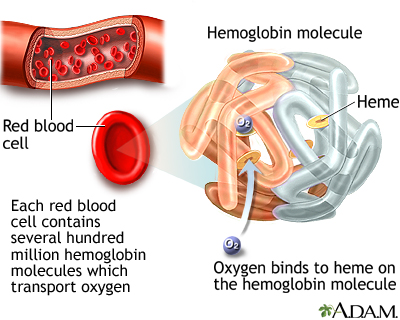Hemoglobin
Hemoglobin is a protein in red blood cells that carries oxygen. The hemoglobin test measures how much hemoglobin is in your blood.
How the Test is Performed
A blood sample is needed.
Blood sample
Venipuncture is the collection of blood from a vein. It is most often done for laboratory testing.

How to Prepare for the Test
No special preparation is necessary.
How the Test will Feel
When the needle is inserted to draw blood, some people feel moderate pain. Others feel only a prick or stinging. Afterward, there may be some throbbing or a slight bruise. This soon goes away.
Why the Test is Performed
The hemoglobin test is a common test and is almost always done as part of a complete blood count (CBC). Reasons or conditions for ordering the hemoglobin test include:
Complete blood count
A complete blood count (CBC) test measures the following:The number of white blood cells (WBC count)The number of red blood cells (RBC count)The numb...

- Before and after major surgery
- Blood in your stools, or vomit (if you throw up)
- Chronic medical problems, such as kidney disease or certain types of arthritis
- During pregnancy
- Fatigue, poor health, or unexplained weight loss
- Headaches
- Heavy menstrual periods
- Leukemia or other problems in the bone marrow
- Monitoring during treatment for cancer
- Monitoring medicines that may cause anemia or low blood counts
- Monitoring of anemia and its cause
- Poor nutrition
- Problems concentrating
Normal Results
Normal results for adults vary, but in general are:
- Male: 13.8 to 17.2 grams per deciliter (g/dL) or 138 to 172 grams per liter (g/L)
- Female: 12.1 to 15.1 g/dL or 121 to 151 g/L
Normal results for children vary, but in general are:
- Newborn: 14 to 24 g/dL or 140 to 240 g/L
- Infant: 9.5 to 13 g/dL or 95 to 130 g/L
The ranges above are common measurements for results of these tests. Normal value ranges may vary slightly among different laboratories. Some labs use different measurements or test different samples. Talk to your health care provider about the meaning of your specific test results.
What Abnormal Results Mean
LOWER THAN NORMAL HEMOGLOBIN
Low hemoglobin level may be due to:
- Anemia
- Bleeding
- Bone marrow being unable to produce new red blood cells. This may be due to leukemia, other cancers, drug toxicity, radiation therapy, infection, or bone marrow disorders
Leukemia
Leukemia is a type of blood cancer that begins in the bone marrow. Bone marrow is the soft tissue in the center of the bones, where blood cells are ...
 ImageRead Article Now Book Mark Article
ImageRead Article Now Book Mark Article - Chronic illness
- Chronic kidney disease
- Destruction of red blood cells (hemolysis)
- Leukemia
- Malnutrition
- Pregnancy
- Too little iron, folate, vitamin B12, and vitamin B6 in the diet
Folate
Folic acid and folate are both terms for a type of B vitamin (vitamin B9). The terms folic acid and folate are often used interchangeably. Folate is...
 ImageRead Article Now Book Mark Article
ImageRead Article Now Book Mark ArticleVitamin B12
Vitamin B12 is a water-soluble vitamin. Water-soluble vitamins dissolve in water. After the body uses what it needs of these vitamins, leftover amo...
 ImageRead Article Now Book Mark Article
ImageRead Article Now Book Mark ArticleVitamin B6
Vitamin B6 is a water-soluble vitamin. Water-soluble vitamins dissolve in water so the body cannot store them. Leftover amounts of the vitamin leav...
 ImageRead Article Now Book Mark Article
ImageRead Article Now Book Mark Article - Too much water in the body
HIGHER THAN NORMAL HEMOGLOBIN
High hemoglobin level is most often caused by low oxygen levels in the blood (hypoxia), present over a long period of time. Common reasons include:
- Bone marrow disease that causes abnormal increase in RBCs (polycythemia vera)
- Cigarette smoking
- Dehydration (for example, from severe diarrhea)
- Failure of the right side of the heart (cor pulmonale)
- Kidney tumor (renal cell carcinoma)
- Low blood oxygen level (hypoxia)
- Problem with heart's structure and function that is present at birth (congenital heart disease)
- Scarring or thickening of the lungs (pulmonary fibrosis)
Your hemoglobin level will increase for several weeks when you are in a higher altitude.
Risks
There is little risk involved with having your blood taken. Veins and arteries vary in size from one person to another and from one side of the body to the other. Obtaining a blood sample from some people may be more difficult than from others.
Other risks associated with having blood drawn are slight, but may include:
- Excessive bleeding
- Fainting or feeling lightheaded
- Multiple punctures to locate veins
- Hematoma (blood buildup under the skin)
- Infection (a slight risk any time the skin is broken)
Reviewed By
Frank D. Brodkey, MD, FCCM, Associate Professor, Section of Pulmonary and Critical Care Medicine, University of Wisconsin School of Medicine and Public Health, Madison, WI. Also reviewed by David C. Dugdale, MD, Medical Director, Brenda Conaway, Editorial Director, and the A.D.A.M. Editorial team.
Kliegman RM, St. Geme JW, Blum NJ, Shah SS, Tasker RC, Wilson KM. Blood disorders. In: Kliegman RM, St. Geme JW, Blum NJ, Shah SS, Tasker RC, Wilson KM, eds. Nelson Textbook of Pediatrics. 21st ed. Philadelphia, PA: Elsevier; 2020:chap 124.
Means RT Jr. Approach to the anemias. In: Goldman L, Cooney KA, eds. Goldman-Cecil Medicine. 27th ed. Philadelphia, PA: Elsevier; 2024:chap 144.
Vajpayee Neerja, Graham SS, Bem S. Basic examination of blood and bone marrow. In: McPherson RA, Pincus MR, eds. Henry's Clinical Diagnosis and Management by Laboratory Methods. 24th ed. Philadelphia, PA: Elsevier; 2022:chap 31.

 All rights reserved.
All rights reserved.